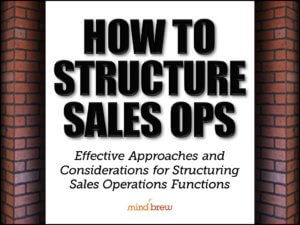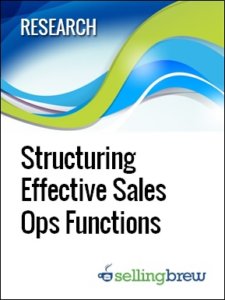One of the easiest ways to get Americans to buy something is to tell them that it’s “natural.” Whether it’s food or shampoo or lawn fertilizer, the “all natural” option is going to get a lot of buyers even if it costs a little more than usual.
Of course, people who are more scientifically minded understand that even if something’s “natural,” that doesn’t necessarily mean that it’s good for you. Sure, aloe vera and coconut oil and fluffy little bunnies are natural, but so are rattlesnake venom, poison ivy, and black widow spiders.
When it comes to the structure of the sales ops team, a lot of organizations take the “natural” approach. The team usually begins when the organization hires someone to manage the CRM software. Over time, more needs crop up. Naturally, every time, the company hires a new person to fill the new niche. Eventually, you end up with a sales ops team comprised of individuals who are each devoted to a particular task. We call this a dedicated functional silo approach to sales ops.
This structure is very common — and very natural.
Unfortunately, it’s also the very worst way to structure a sales ops team.
When each person on the team focuses on a particular functional area, you end up with a lot of headcount because every time something new comes up, you have to hire more people.
In addition, this approach is inefficient because it results in a lot of overlap. For example, you might have hired a team to focus on customer retention, but the reporting team and the training team also deal with retention. That means a whole lot of people are focused on retention, which may have only been a short-term need from the beginning.
With this structure, your team members are going to be specialists rather than generalists. If you hire someone to run reports, he or she is going to know a lot about how to run those reports but might lack the kind of strategic mindset that is really necessary for using those reports effectively.
This structure also isn’t very nimble. If the business’s needs change, it will be hard to move those specialists over to new responsibilities quickly. Often, the company finds that it needs to hire more people, and that process can be long and cumbersome.
If this is starting to sound a lot like your sales ops team, please understand that you are not alone. The vast majority of B2B sales ops teams start with this kind of structure and encounter these problems. In fact, questions about how to structure sales ops teams are among the most frequent we get here at SellingBrew.
Fortunately, there are several alternatives to dedicated functional silos. These different options tend to have their own strengths and weaknesses, and one may be better than others for your particular needs. To learn more, watch the webinar How to Structure Sales Ops. It looks at three different structural models that have proven themselves effective and offers a lot of tips and techniques for improving team structure.
You might also want to check out Developing a Winning Sales Operations Roadmap, the Q&A on How Should a Sales Ops Function Be Structured?, and the research on Structuring Effective Sales Ops Functions.
You may have unknowingly structured your sales ops team in the worst possible way, but it doesn’t have to stay that way. These resources identify best practices that can help your team become more agile and efficient.














